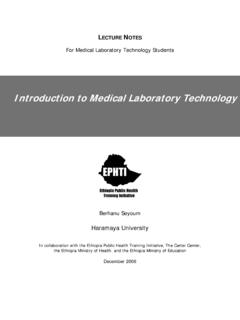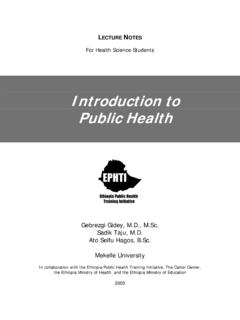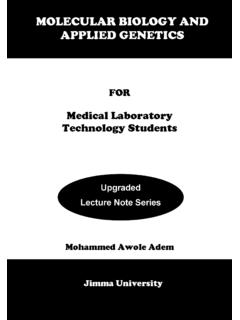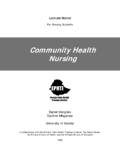Transcription of Nursing Leadership and Management - Carter Center
1 LECTURE NOTES For Nursing Students Nursing Leadership and Management Amsale Cherie Ato Berhane Gebrekidan Addis Ababa University In collaboration with the Ethiopia Public Health Training Initiative, The Carter Center , the Ethiopia Ministry of Health, and the Ethiopia Ministry of Education 2005 Funded under USAID Cooperative Agreement No. 663-A-00-00-0358-00. Produced in collaboration with the Ethiopia Public Health Training Initiative, The Carter Center , the Ethiopia Ministry of Health, and the Ethiopia Ministry of Education.
2 Important Guidelines for Printing and Photocopying Limited permission is granted free of charge to print or photocopy all pages of this publication for educational, not-for-profit use by health care workers, students or faculty. All copies must retain all author credits and copyright notices included in the original document. Under no circumstances is it permissible to sell or distribute on a commercial basis, or to claim authorship of, copies of material reproduced from this publication. 2005 by Amsale Cherie and Ato Berhane Gebrekidan All rights reserved.
3 Except as expressly provided above, no part of this publication may be reproduced or transmitted in any form or by any means, electronic or mechanical, including photocopying, recording, or by any information storage and retrieval system, without written permission of the author or authors. This material is intended for educational use only by practicing health care workers or students and faculty in a health care field. iPREFACE The rapid change in technology, knowledge explosion and the increased and complex health care demands challenge the nurse's knowledge, technical competence, interpersonal skills and commitment.
4 Nurses work at each level of the health care system, have varied role, and are constantly in contact with people. Dealing with this dynamism and responsibility requires nurses to have knowledge and skills of Management . It becomes apparent that the Leadership needed to get work done through people is increasingly important for nurses to dispose their professional performance. Furthermore, proactive leaders who had a vision and could motivate associates to work toward common goals could help organization survive and even thrive during rapid change.
5 Although, this is the case teaching materials in this endeavor are scarce in Ethiopia. Therefore, this lecture note is written to narrow this gap. The target audiences for this teaching material are student nurses at BSc level and nurses working at each level of the health care system. This material is not intended to substitute other iiteaching and reference materials. Its objective is to provide useful insights and information on Management in general and Nursing Management in specific.
6 The lecture note is organized into fourteen chapters. Chapter one to five deals with introduction to Management and Nursing service administration; mission, philosophy and goals of an organization; organization and organizational structure; functions of Management and decision making respectively. Theories of Leadership , Management of resources, evaluation of health care activity, and communication and group dynamics are the topics dealt in chapters 6, 7, 8, 9, and 10 respectively.
7 In addition, conflict resolution; Management of change, project Management and quality assurance are discussed in chapter 11, 12, 13 and 14 in its order. iiiACKNOWLEDGMENTS We want to express our heart-felt gratitude to the Carter Center , EPHTI for providing us financial and technical assistance to materialize this lecture note. We are also indebted to Ato Aklilu Mulugeta Business Manager, for the Carter Center , Addis Ababa for the administrative support and encouragement.
8 Almaya, Dila, Gondar and Jimma University staffs deserve special acknowledgment for reviewing and providing invaluable comments. Our deepest appreciation goes to Ato Befekadu Tesgera from Salam Nurses College for reviewing this lecture note. We want to extend our sincere thanks and gratitude to Centralized School of Nursing Addis Ababa University and Defense University for their unreserved support for the completion of this teaching material. ivTABLE OF CONTENTS Preface.
9 I Acknowledgement ..ii Table of Contents ..iv CHAPTER ONE: Introduction to Nursing Service Management .. 1 Definition of Management and Nursing service administration .. 2 Types of managers .. 6 Managerial Skills .. 7 Managerial roles .. 8 Health Service Organizational Model .. 10 Learning activities .. 11 CHAPTER TWO: Philosophy of Nursing Service Management .. 12 Organizational philosophy and philosophy of Nursing service administration.
10 13 Goals .. 15 Institutional Goals .. 16 Nursing Department Goals .. 16 Nursing Unit Goals .. 17 vOrganizational Climate .. 18 Learning Activities: .. 18 CHAPTER THREE: Organization and organizational structure .. 19 Systems Theory .. 20 Organizational Structure .. 25 Organizational Characteristics .. 27 Organizational Principles .. 29 Organizational Concepts .. 29 Types of Formal Organization Structures .. 31 Line and Staff Pattern/Relationship/in an organization .. 34 Matrix Organizational Structure.










